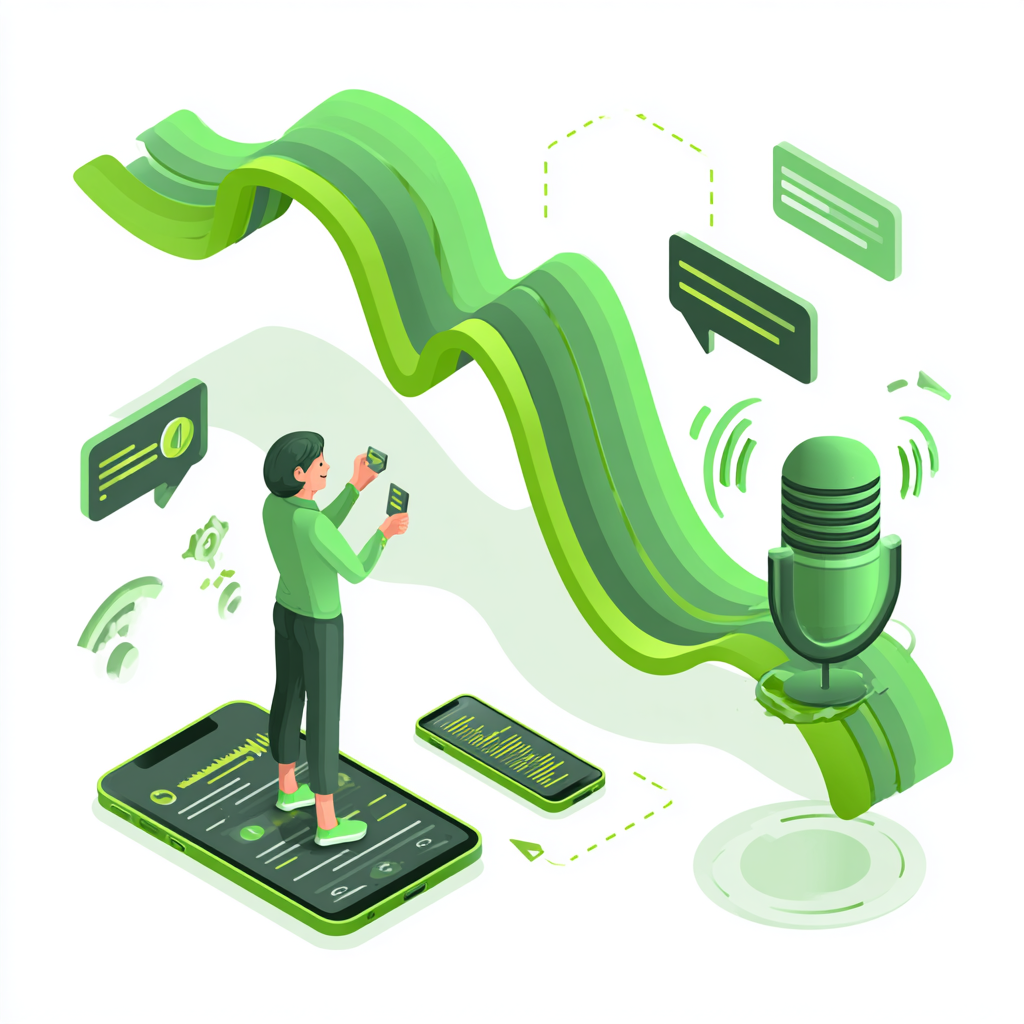Modern technology like voice SMS has revolutionized communication. This technology allows communication to be done effectively by combining the personal touch of voice with the ease of SMS. Do you want to reach out to many people for personal or work needs? Or are you running a business and want to increase customer satisfaction? Mastering voice SMS can open up a whole new world.
This article will guide you about voice SMS, its benefits, features, and how to use it well, whether you are just one person or a business.
What is voice SMS
Voice SMS is an automated technology that lets people record and send voice messages to others through phone calls. This system helps users connect with their audience by showing their emotions and personalities through their voice. Voice SMS was first introduced in the 1990s, and it has since improved communication and added a more personal touch.
With voice SMS, we can express our thoughts and emotions through our voices’ natural inflections and tones.
Who can use voice SMS?
Everyone can use voice SMS. Businesses and individuals can benefit from the voice SMS service. Voice SMS is the way to go if you want to share or get information from a large audience. Businesses can use voice SMS to manage customer service and front desk operations in a more personalized way.
Businesses can use voice SMS to send pre-recorded reminders to pay bills, set notifications to remind customers of important events, promote new offers, confirm orders and delivery, and collect surveys.
Types of voice SMS
The most popular types of voice SMS are text-to-speech, pre-recorded audio, and interactive voice response
1. Text-to-speech
Text-to-speech (TTS) technology converts written text into speech. It is used in various industries for customer engagement, virtual assistance, and accessibility.
2. Pre-recorded audio
Pre-recorded audio refers to voice messages recorded and stored beforehand. It provides options for connecting customers over TTS and is especially great for delivering standardized messages such as greetings, product information, or customer service scripts.
3. Interaction voice response (IVR)
IVR is an automated pre-recorded voice menu system that allows callers to interact using their phone keypad or voice commands. This method is especially great for effective customer care, emergency calls, banking transactions, customer feedback, and automated notification alerts.
Benefits of Voice SMS
Businesses and Individuals benefit significantly from using voice SMS. This personalized mode of communication makes it easier to reach out to friends and family.
1. Convenience
Voice SMS can save time, allowing users to communicate easily without typing. Users record and send messages. Customers can then listen and replay if they initially do not understand.
2. Enhanced personalization
Voice SMS conveys messages with greater emotional depth. It is the best way to convey sentimental and intimate messages, building trust.
3. Accessibility
Voice SMS is an excellent way to reach people with visual or manual impairments, including those who find it hard to reply to text messages. Compared to regular SMS, voice SMS makes contacting such individuals simpler.
4. Support for multiple languages
Voice messages make it easy to communicate with your target audience, regardless of their language. Voice SMS also allows the targeted audience to listen to the message in their language of preference, which increases customer engagement.
5. Avoids miscommunication
Voice SMS lets you hear the inflections and subtleties of the speaker’s voice as the listener. This makes the message more understandable to the audience, reducing the likelihood of miscommunication.
6. Competitive advantage
Voice SMS offers a more engaging and personal method of connecting with customers, which helps a business stand out from the competition. Businesses utilizing voice messaging early can reinforce brand identity and recognition, shape industry trends, and establish companies as pioneers.
7. Increased productivity
Voice SMS systems can automate tasks, reducing staff workload. Customer care representatives can focus on other tasks, while AI can handle basic customer inquiries.
8. Improved customer experience
Compared to standard SMS, voice SMS offers a more intimate touch. Customers receive personalized messages that make them feel valued and understood. Voice SMS is also an easy and accessible way to communicate. They can get important notifications, updates, and reminders without reading text messages or emails. However, voice SMS can be replayed multiple times to reduce miscommunication and misunderstanding.
9. Efficient internal communication
Voice SMS can improve teamwork and reduce the need for long emails and conference calls. Businesses can also use voice SMS to inform staff of important deadlines and inquiries.
10. Cost-effective
Generally speaking, voice SMS is less expensive than other types of communication, such as regular SMS or phone calls. This is especially true for bulk SMS messages.
11. Increased engagement
Customers interact with a brand more when they receive voice SMS messages because of their personalized touch. Customers are more likely to listen to a voice message than to read a text, leading to higher open and response rates. Mastering Voice SMS fosters two-way communication, empowering customers to respond promptly and effortlessly.
Businesses can use voice SMS to ask questions and collect surveys, increasing engagement and showing customers that their opinions are essential. This increased engagement leads to better customer relationships, greater loyalty, and revenue growth.
Best practices for mastering voice SMS
Individuals and businesses alike can use voice SMS to communicate with their audience actively. Whatever your reason for using Voice SMS, you must follow best practices to ensure success. This personalized communication mode makes reaching out to your audience easier.
1. Speak clearly
Make sure what you are saying is easy to understand. Correctly pronounce your words. Avoid filler words, mumbling, or background noise that will make it difficult for the recipient.
2. Keep messages short
Voice SMS allows you to send long messages. However, make sure your messages are concise and direct. Aim to keep your voice SMS to under 60 seconds.
3. Use emotions
Express emotions and tone to your voice when sending your voice message. Avoid speaking in a monotone voice. Make sure to vary the tone of your voice. For example, exciting news will require the speaker to talk in a higher voice. Make sure the tone of voice is both professional and friendly.
4. Personalize messages
Personalize messages to reach the heart of the audience. You can add the customers’ names or order numbers to the greeting. Voice SMS can be modified to include other personal details about the customers. Voice SMS can also include background music to give it a more human feel.
5. Automate messages
Use the services of a reputable voice SMS service provider to have your messages automated.
6. Measure engagement
Monitor response rates and engagement metrics to improve voice SMS strategies. Measuring will help you to adjust your voice SMS accordingly.
7. Check before sending
Always check your voice messages before sending them. Examine the recording for any errors that could lead to confusion and background noise. Ensure that the audio quality is clear. The message should be accurate.
8. Leverage scheduling and reminders
Voice SMS applications have features that let you schedule and send messages at the best possible time.
9. Encourage response
Ensure the customer can give feedback. This response could be in the form of voice sms or SMS. By doing so, the customers can express themselves, and you can get valuable feedback.
How to use voice SMS
Here are the top tips for using voice SMS
1. Pick your objective
Before you record your voice message, decide on an objective. Do you want to provide new offers to your customers? Is it a follow-up? Is it for reminders?
2. Select the appropriate method
You can choose whether to use interactive voice response (IVR) or pre-recorded messages. Choose the one that best suits your objective.
3. Set up the system
Pick the best provider of voice SMS services. Arkesel can plan and optimize your campaigns for the best locations and times for your target audiences. Personalize messages to meet your specific goals.
4. Manage and analyze interactions
Use the system you have chosen to capture and analyze customer interaction. Utilize it to gain insight and improve further communication. Arkesel provides its users with meaningful reports that make it easy to gain insights into your dashboard.
Communicate better and smarter.
Voice SMS is indeed a force in the communication world. It has made messaging more personalized and effective, and this technology has empowered both individuals and businesses. Whether scheduling appointments or sharing important updates, mastering voice SMS is an important tool for achieving goals. Businesses have also embraced voice SMS to improve customer service and optimize internal operations.
Businesses can use voice SMS to automate daily interactions and ensure information is received and well understood. Above all, mastering voice SMS empowers individuals and businesses to communicate more intimately with family, friends, and customers. With the guidance given in this guide, you can now take advantage of voice SMS and take your communication strategies to the next level. Embrace the power of voice SMS and enjoy a world of personalized and efficient communication.





